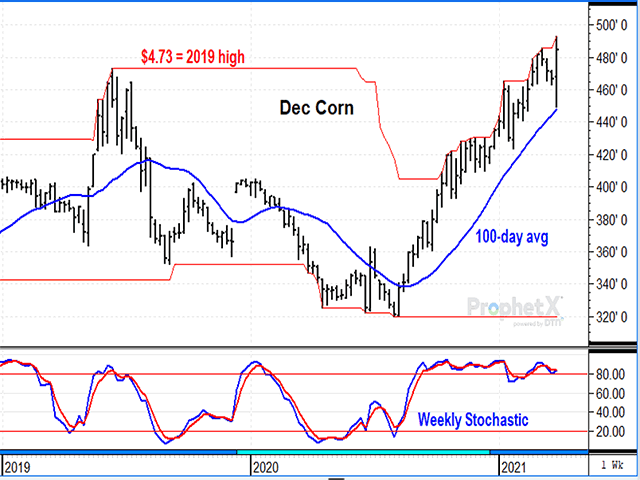Todd's Take
New-Crop Corn Not Done Yet
For U.S. farmers, one of the real delights to come out of last year's pandemic-dominated markets was to witness the astonishing bull move in corn prices. Propelled by a late stretch of dry weather in the U.S. and what looks like nearly a billion bushels of corn sales to China, spot corn prices hit a high of $5.74 1/4 in February, and it was fair to wonder if that was the end of the road for corn.
For December corn, prices hit a March high of $4.85 3/4, and I was having strong arguments with myself about whether that was the top. It seemed obvious with new-crop prices near six-year highs, planting incentives would be high this spring and many pre-report estimates favored corn acres over soybeans.
Prior to the Prospective Plantings and March 1 Grain Stocks reports, Dow Jones' survey estimate of 93.1 million corn acres seemed reasonable and was not the highest we heard. Also looming over the market is the uncertainty of China's demand in the new season. On Tuesday, we saw China's spot corn price fall to its lowest close in three months, a bearish sign China's large purchases are finally starting to bring down the domestic price, at least for now.
The bullish signs for spot corn convinced me to not rush and give corn prices room to trade. Tuesday's lower closes in corn changed the trend to sideways, but the May contract showed a premium of 16 3/4 cents over July. The basis for DTN's National Corn Index fell to 10 cents, the strongest showing for cash prices relative to the futures board since 2012-13.
P[L1] D[0x0] M[300x250] OOP[F] ADUNIT[] T[]
Corn's seasonal tendency suggests there is still time for corn, as the usual declines in prices typically happen after early June. In 2021, we also have a lot to learn about early threats of drought in the Western Corn Belt. As usual, weather will be an important part of where prices go from here.
Going through the DTN Six Factors checklist, none of the market clues by themselves offered ironclad guarantees, but putting them all together persuaded me to give new-crop corn prices more time before recommending another forward sale. Now, looking at the Wednesday, March 31, limit-up close and higher trade again on Thursday, I'm glad we held off.
There is one nagging item that doesn't have an easy answer: Nobody knows how good or bad Wednesday's planting estimates from USDA were. Intentions are funny things, and we all know intentions in early March aren't the same as actual planting work in May and June. Last year, 97.0 million acres of corn planting intentions in March turned into a 92.0 million-acre estimate of corn plantings at the end of June. There is room for the numbers to swing higher in 2021.
For the next three months, traders may act as if Wednesday's planting estimates are reliable, but I recommend a healthy dose of skepticism. For growers in areas not threatened by drought or that have the benefit of irrigation, there should soon be a better opportunity to make a cautious amount of forward sales. There is plenty of uncertainty ahead, but new-crop corn prices at six-year highs are nothing to sneeze at.
**
Comments above are for educational purposes and are not meant as specific trade recommendations. The buying and selling of grain and grain futures involve substantial risk and are not suitable for everyone.
Todd Hultman can be reached at Todd.Hultman@dtn.com
Follow him on Twitter @ToddHultman1
(c) Copyright 2021 DTN, LLC. All rights reserved.




